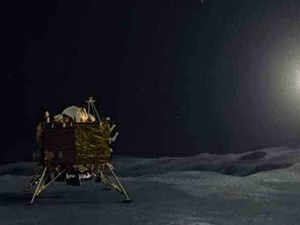 Agencies
AgenciesCHENNAI: It was not rocket science but a painstaking pixel-by-pixel comparison of nearly 30 images that helped Chennai techie Shanmuga Subramanian spot Vikram lander’s debris after it crashed on the lunar surface on September 7.
The 33-year-old, who hails from Madurai, woke up on Tuesday to an email from Nasa confirming that the American space agency has confirmed Vikram lander’s crash site and giving him credit for the discovery.
“I spotted the debris about 0.75km north of the lander’s intended landing location. All I did was a basic apples-to-apples comparison of two images at a time on the computer screen. No software or complex calculation, just an old school method,” said the mechanical engineer and programmer who friends call Shan. “It didn’t require a lot of science, but a basic understanding of lunar days and nights and the surface of the moon,” he said.
A day after Vikram went missing, Isro said it had located the lander, but did not publish any image. Nasa’s analysis of its Lunar Reconnaissance Orbiter (LRO) images too did not reveal any impact scar on the lunar surface. Shan downloaded a 1.5GB resolution image of the region on the moon published by Nasa on September 17 and compared it with nearly 30 old images captured by the LRO which has been circling the moon for a decade, with a 1.25m resolution per pixel. Some simple calculations with data on the lander’s path and last known velocity available on the public domain, Shan decided to search for the debris on the north side.
“During the landing, a few radio astronomers had tweeted that the lander had crossed the north pole. With that, I figured out that the debris must be within a 2km x 2km area north of the landing spot,” he said. Placing two ‘before’ and ‘after’ images on his screen, Shan zoomed in pixel by pixel and compared. When he noticed a white speck on the new image that was not visible in the old images, he knew it. “There is a definite difference that you can tell between a man-made object and others. For instance, a man-made object would be less illuminated and smaller than a boulder,” he said.
A graduate from Government Engineering College, Tirunelveli, Shan is a weather and space enthusiast. His phone has not stopped ringing since Tuesday morning when he posted Nasa’s email on his social networking site.
The 33-year-old, who hails from Madurai, woke up on Tuesday to an email from Nasa confirming that the American space agency has confirmed Vikram lander’s crash site and giving him credit for the discovery.
“I spotted the debris about 0.75km north of the lander’s intended landing location. All I did was a basic apples-to-apples comparison of two images at a time on the computer screen. No software or complex calculation, just an old school method,” said the mechanical engineer and programmer who friends call Shan. “It didn’t require a lot of science, but a basic understanding of lunar days and nights and the surface of the moon,” he said.
A day after Vikram went missing, Isro said it had located the lander, but did not publish any image. Nasa’s analysis of its Lunar Reconnaissance Orbiter (LRO) images too did not reveal any impact scar on the lunar surface. Shan downloaded a 1.5GB resolution image of the region on the moon published by Nasa on September 17 and compared it with nearly 30 old images captured by the LRO which has been circling the moon for a decade, with a 1.25m resolution per pixel. Some simple calculations with data on the lander’s path and last known velocity available on the public domain, Shan decided to search for the debris on the north side.
“During the landing, a few radio astronomers had tweeted that the lander had crossed the north pole. With that, I figured out that the debris must be within a 2km x 2km area north of the landing spot,” he said. Placing two ‘before’ and ‘after’ images on his screen, Shan zoomed in pixel by pixel and compared. When he noticed a white speck on the new image that was not visible in the old images, he knew it. “There is a definite difference that you can tell between a man-made object and others. For instance, a man-made object would be less illuminated and smaller than a boulder,” he said.
A graduate from Government Engineering College, Tirunelveli, Shan is a weather and space enthusiast. His phone has not stopped ringing since Tuesday morning when he posted Nasa’s email on his social networking site.
Read More News on
(Catch all the Business News, Breaking News, Budget 2024 News, Budget 2024 Live Coverage, Events and Latest News Updates on The Economic Times.)
...moreDownload The Economic Times News App to get Daily Market Updates & Live Business News.
Subscribe to The Economic Times Prime and read the ET ePaper online.
Read More News on
(Catch all the Business News, Breaking News, Budget 2024 News, Budget 2024 Live Coverage, Events and Latest News Updates on The Economic Times.)
...moreDownload The Economic Times News App to get Daily Market Updates & Live Business News.
Subscribe to The Economic Times Prime and read the ET ePaper online.






